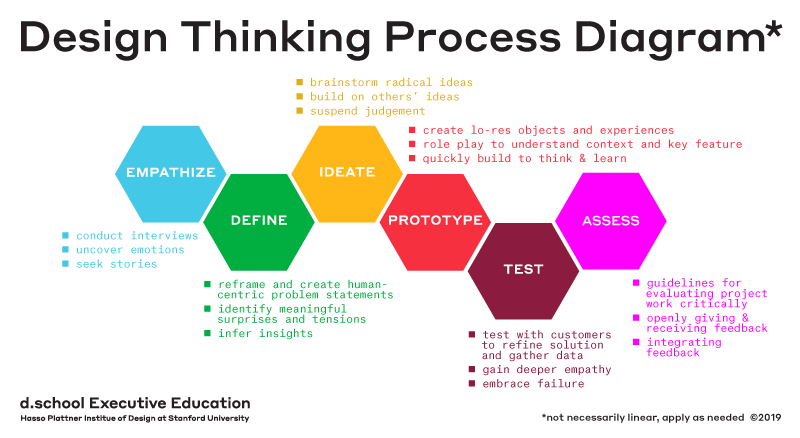Brainstorming is an activity that will help you generate more innovative ideas.
It’s one of many methods of ideation—the process of coming up with new ideas—and it’s core to the design thinking process. It’s a skill that you can build within your team and organization to help bring new ideas to life.
1. Sharpen the Focus. Specify problem.
Good brainstormers start with a well-honed statement of the problem. This can be as simple as a question. Edgy is better than fuzzy. The session will get off to a better start—and you can bring people back into the main topic more easily—if you have a well-articulated description of the problem at just the right level of specificity.
A brainstormer without a clear problem statement is like a company without a clear strategy: You’ll wander aimlessly and need a lot of extra luck or talent to succeed. If you find yourself leading a session that lacks direction, spend a few minutes developing a good problem statement.
2. Playful Rules. This is not a meeting.
Don’t start to critique or debate ideas. It can sap the energy of the session pretty quickly. You need a way to turn aside critiques without turning off the critiquers completely. Perhaps the facilitator could ring a bell when participants try to turn a brainstormer into a normal meeting. Or you could print the brainstorming rules on a giant Post-it or write them prominently on a whiteboard.
3. Number Your Ideas. Strive for 100.
Numbering each idea is pretty obvious, right? So obvious that it took us almost ten years to figure it out. Numbering the ideas that bubble up in a brainstorm helps in two ways.
First, it’s a tool to motivate the participants before and during the session (“Let’s try to get a hundred ideas before we leave the room”) or to gauge the fluency of a completed brainstorm.
Second, it’s a great way to jump back and forth from idea to idea without losing track of where you are.
We’ve found that a hundred ideas per hour usually indicates a good, fluid brainstorming session. One hundred and fifty per hour is pushing the speed limit. Of course, it’s quality that ultimately matters, but we’ve heeded Linus Pauling’s advice to get a lot of ideas.
4. “Build” and “Jump”. Move it along.
Watch for chances to “build” and “jump.” High-energy brainstormers tend to follow a series of steep “power” curves, in which momentum builds slowly, then intensely, then starts to plateau. The best facilitators can nurture an emerging conversation with a light touch in the first phase and know enough to let ideas flow during the steep part of the ideation curve. It’s when energy fades on a line of discussion that the facilitator really earns his or her keep.
Try building on an idea. Encourage another push or introduce a small variation. Or take a jump, either back to an earlier path you skipped by too quickly or forward to a completely new approach. Whatever you do, try to get into the next power curve and keep the energy up.
5. The Space Remembers.
Great brainstorm leaders understand the power of spatial memory. Write the flow of ideas down in a medium visible to the whole group. Brainstorming is an intensely group-oriented process, and the facilitator’s rapid scribing is one of the focal points that hold the group together. We’re not talking about taking personal meeting notes here, but capturing ideas so that the group can see their progression and return to those that seem worthy of more attention.
6. Stretch Your Mental Muscles. Warm up.
People are busy. Time is short. Is it worthwhile to “burn” some time at the beginning of a brainstorm doing some form of group warm-up? Maybe. But that “maybe” rapidly becomes a “yes” in certain circumstances:
When the group has not worked together before
When most of the group doesn’t brainstorm frequently
When the group seems distracted by pressing but unrelated issues
One type of warm-up we practice is a fast-paced word game simply to clear the mind (Zen practitioners call it “beginner’s mind”) and to get the team into a more outgoing mode. While these group exercises done in a circle may seem like you’ve been transported to your toddler’s Gymboree class, they help ground you in the group and temporarily blot out worries about the latest operational glitch or the unread e-mails waiting back at your computer.
7. Get Physical. Prototype.
Good brainstorms are extremely visual. They include sketching, mind mapping, diagrams, and stick figures. You don’t have to be an artist to get your point across with a sketch or diagram. Leave your performance anxieties at the door and jump in with whatever visual tools you have available.
But the best brainstormers often get physical.
The first way we do this is to bring in everything but the kitchen sink (and we’ve brought the sink, too, when it was relevant). That means competitive products, elegant solutions from other fields, and promising technologies that could be applied to the problem.
The second way we get physical is to have materials on hand to build crude models of a concept: blocks, foam core, tubing, duct tape, whatever might be useful.
The third physical approach is “bodystorming,” where we act out current behavior/usage patterns and see how they might be altered. We’ve bodystormed on products ranging from vending machines to car seats, where our skits and scenarios pointed to all kinds of opportunities for improvement.

